I think it’s a matter of “when” not “if” to have AI or non-AI tools that can source and screen profiles well enough. What will be a human’s role in sourcing then? The answer is to guide and plan the search strategically. But how do we do sourcing planning now? Most of the time, the answer is we do not or at least not in a systematic way. This is exactly why we should talk more about sourcing planning and strategy.
As recruiters, we have a lot on our plates. Especially if you are a one-person department. You run everything from confirming requirements to crafting onboarding plans. And a bit of office management, because you have the capacity, right? 🤡
It feels like if we add anything else to that plate, it will overflow. Sourcing planning and even strategy is often thought to be the extra dressing that we can skip. In reality, sourcing planning done right feels like that awesome new meal plan (the one you didn’t get tired of yet). It helps you organize your food, save time and can get you a bit more excited to prepare your food!
Sourcing planning will help you:
⏵ Keep track of your search
⏵ Transition to backup plans more easily
⏵ Simply pivot the search strategy when the talent pool is exhausted
Disclaimers first: this post is my thinking process out loud. I’m curious to share and discuss but also learn how other people plan and strategize their sourcing! So feel more than welcome to share your thoughts! 🫶🏽
Navigating the sourcing journey – from research to engagement (and the ‘Travolta Trap’)
We all know recruitment phases but what are the sourcing phases? In general, I follow the below process:
1. Intake & role research: intake with Hiring Manager (HM), talent mapping
2. Search strategy: finalizing the profile with HM, the decisions on the talent we target (talent persona, geography, active/passive, etc)
3. Sourcing planning: outline steps for sourcing talent (the focus of this article)
4. Sourcing implementation: running the search, screening and selecting prospects
5. Talent engagement: reaching out to potential candidates (depending on personal style done simultaneously with Sourcing implementation)
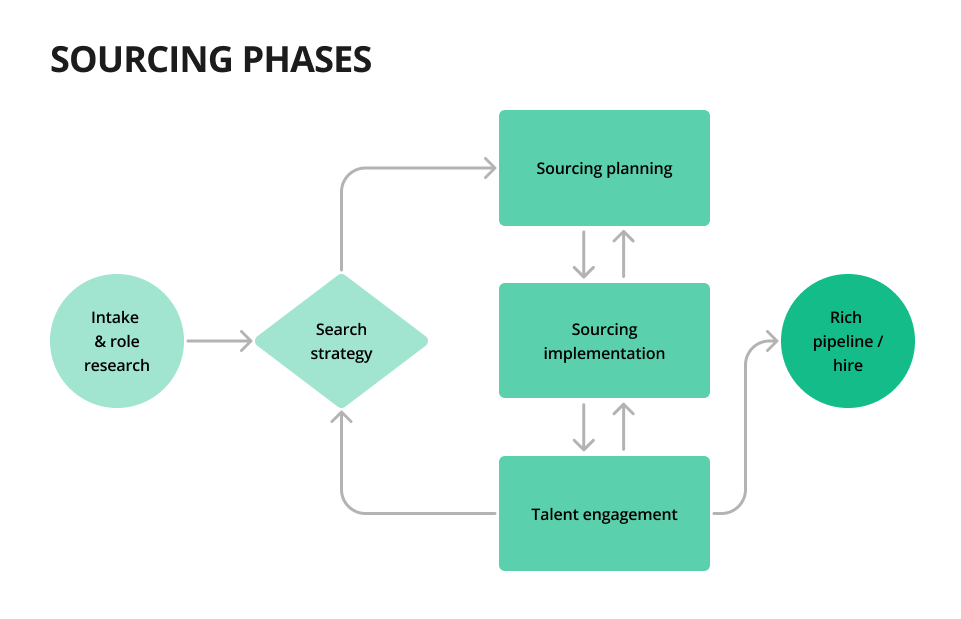
Sometimes there is this extra stage, let’s name it after Travolta as a tribute to this iconic scene. Sourcer is confused and has zero clue what is happening and what to do next. I also call it the “there are no candidates left: part 1” stage. There are situations when you exhaust the whole market and there are no candidates left. In my experience, the first time you feel you got to the bottom of it is not the actual moment the talent pool runs out. Sourcing planning gives you perspective and data on your efforts so far and the next steps.

However, if you have your planning tracked, you never have the “Travolta stage”. You go straight into the next step in your plan or go back to Search strategy!
Sourcing Planning: Iterative sourcing vs. Donor sourcing
So, how you can plan your passive candidates’ sourcing? There are two major ways I choose from when planning my sourcing – Iterative Sourcing and Donor Sourcing.
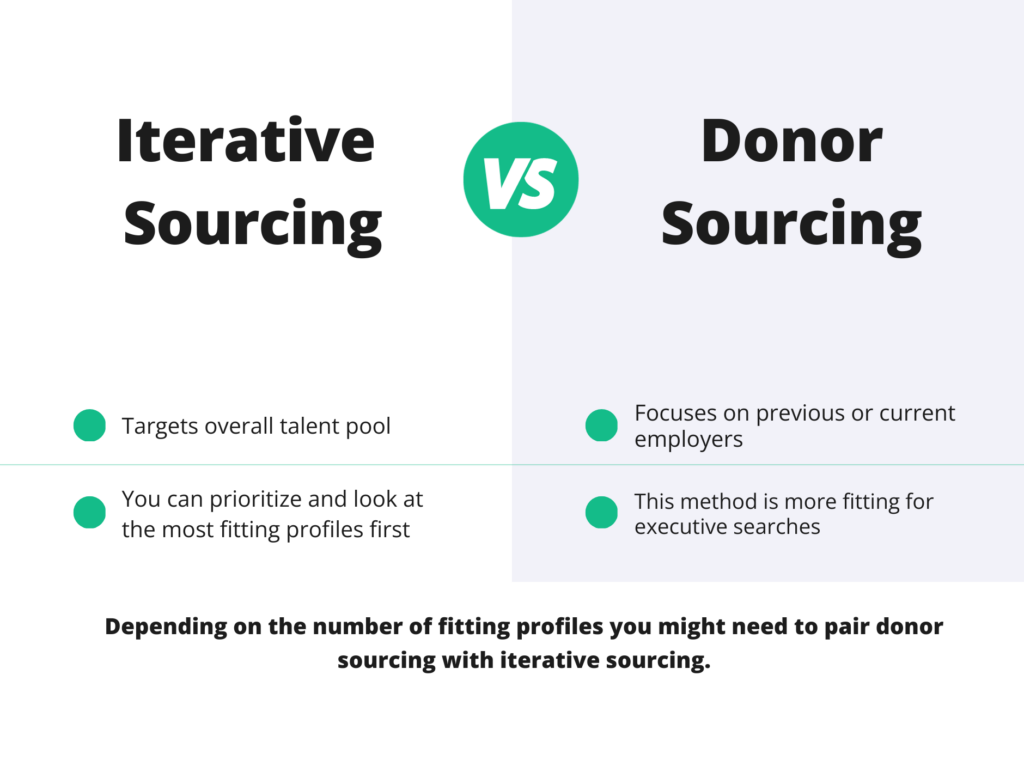
Iterative Sourcing targets the overall talent pool and chunks it. You can prioritize and look at the most fitting profiles first. I’d say this is the default scenario for me.
Donor Sourcing focuses on previous or current employers. It does not ignore the rest of the requirements of course. This method is more fitting for executive searches. Depending on the number of fitting profiles you might need to pair donor sourcing with iterative sourcing.
Iterative Sourcing
Okay, let’s craft our iterative sourcing plan now. For the sake of this example, I’m using LinkedIn Recruiter Lite search. The goal of this article is not to explore the boolean, so let’s go with simple example searches.
1. Map your overall available talent pool
For this, we need to translate must-have requirements to sourcing keywords.
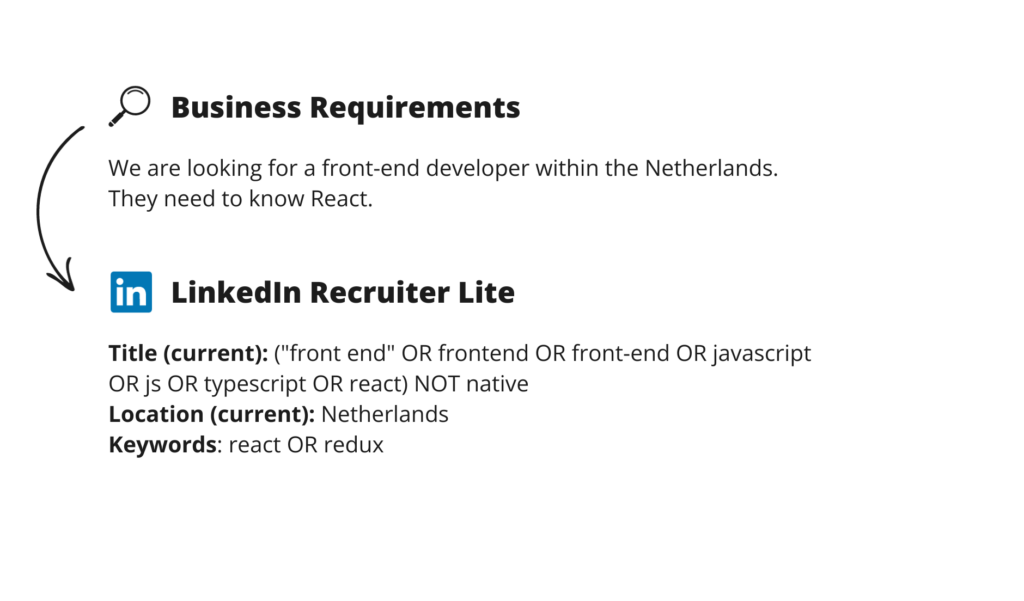
In this specific case, we have around 4.3k results to work with.
Explanation: Our main desirable talent pool is people who consider themselves front-end developers. This is why we use the Title field. We use synonyms to target all possible ways people use front-end titles on LinkedIn. We search for the current title because we are not interested in someone who was a front-end developer before but is now a CTO. We also use Keyword search because we want to have only people who have an indication of React knowledge. React or Redux anywhere on the profile together with the relevant title is enough to take a look at the result profiles.
2. Craft the first iteration
If we start randomly making our way through those 4.2k results, we will get lost and it is now sorted as LinkedIn wishes. We can make it better and make sure we look at our most desirable candidates first. It’s now time to divide our main talent pool into smaller, prioritised and manageable ones. This is the perfect time to remember about nice-to-haves we have.
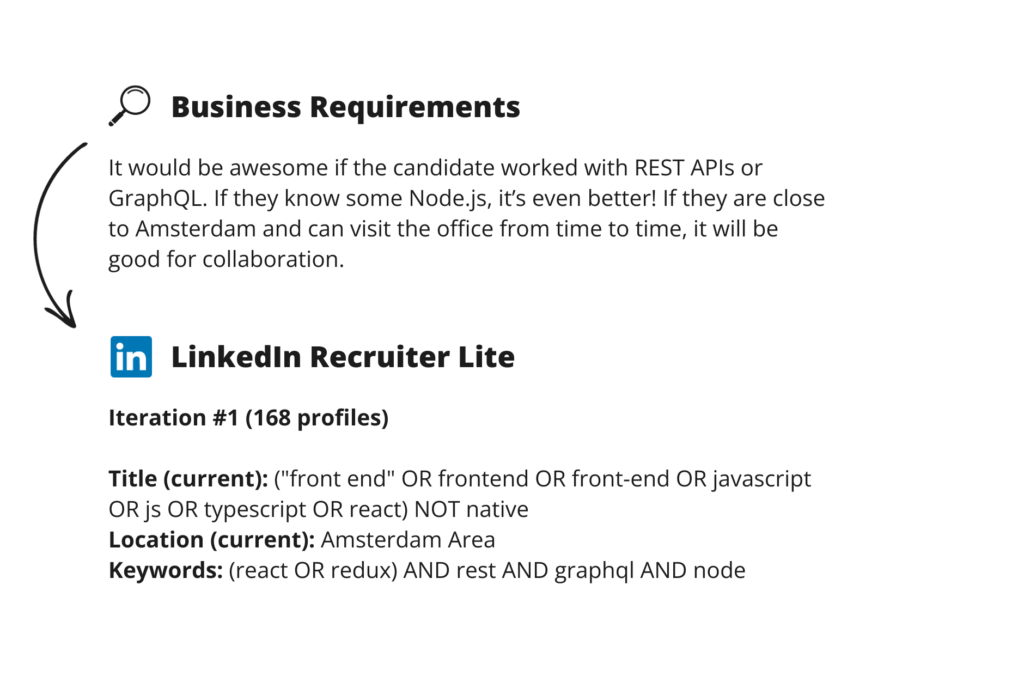
This will give us 168 results. This is a good start and we are done with our first iteration!
Explanation: We kept our main requirements intact and only added more on top of them to narrow down the search. You can notice that the first time around we were mainly working with adding more and more OR operators because we wanted to have the whole available market, now we are adding more AND operators. GraphQL, REST API and Node.js are easy keywords to add. We didn’t add API to REST because some people will mention REST principles, and we are interested in seeing them. It opens the room for some error, for example, a front-end developer that said something like “ The rest of the time…” on their About section will show up, but that is a neglectable error and is still within our scope of interest.
3. Keep the iterations going
If we are lucky, we will source our hire from this first iteration, but we of course need a backup! Now our goal is to continue forward to the other chunks of the overall talent pool we mapped out in the first step.
We are going to keep the core requirements outlined in the first step and alternate between keywords or introduce new differentiators to chunk the whole talent pool of ±4.3k profiles into manageable cohorts. Something very important: you want your search results not to overlap! Because who wants to look at the same profiles again and again? 🤷
I typically design 4-5 strings or more. The number or pre-designed strings depends on talent pool size and whether I’m looking for one person or working on a serial role. I’d advise having around 150 results per string so that it is doable in one sit and you never have to deal with LinkedIn reshuffling your results.
Let’s go for an extended location first, because the Amsterdam Area is only a preference and typically talent can travel to Amsterdam from anywhere within the Netherlands.
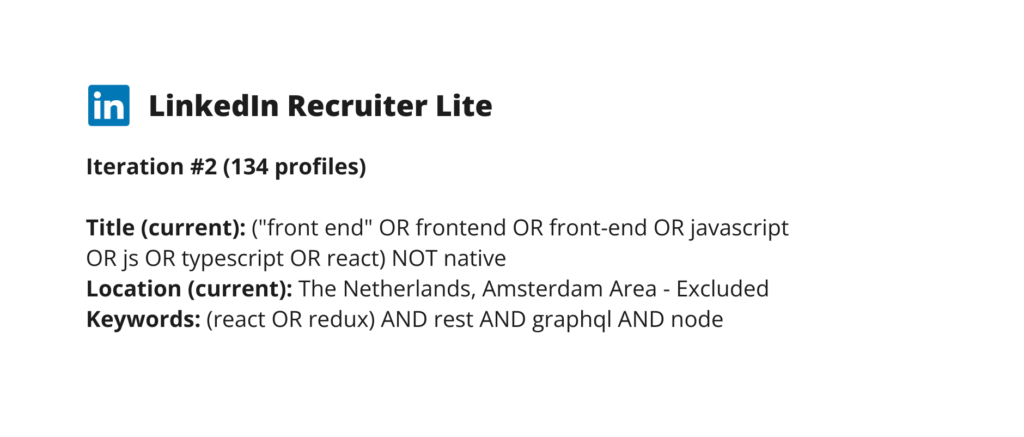

Excluding Amsterdam Area
from our search
This will give us 134 results and no overlap because we are looking at any location in the Netherlands, but not the Amsterdam Area. The rest of the keywords stay the same.
Next in this example, I’d like to keep at least one of the preferences and now go for excluding nice-to-have keywords we introduced but include a restriction on location and go for Amsterdam Area.
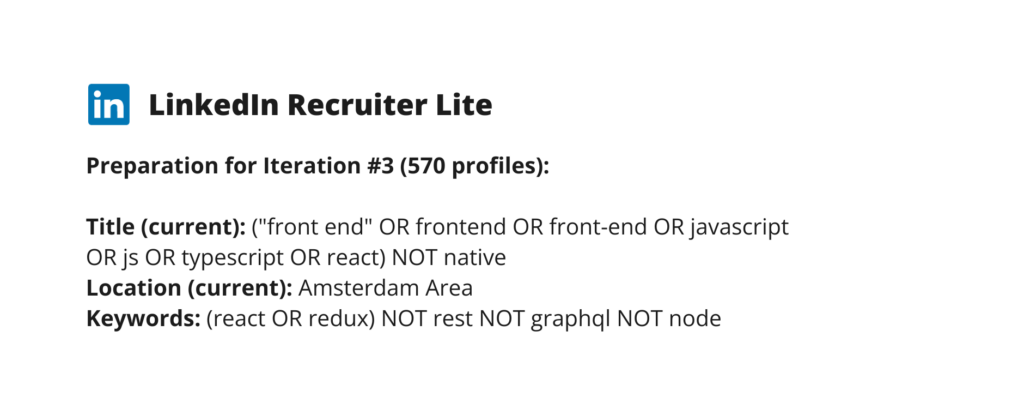
However, this gives me 570 results, which is too much to cover in one sitting. I want to meaningfully assess the profiles I’m reviewing. So, how can I meaningfully chunk this further? Now it’s up to the sourcers’ creativity! You can go for new keywords, language of profile, school, years of experience, etc. If you have been cooperating with the same Hiring Manager for a long time, you already know implicit requirements that you can incorporate into your search. If not, try to take a guess and learn from it! In this case, I will go for years of experience. Using the Years of Experience filter, I will chunk it between 4-8 years and then 8-12 (because we are looking for someone hands-on and individual contributors, who are more likely to be in these experience ranges).
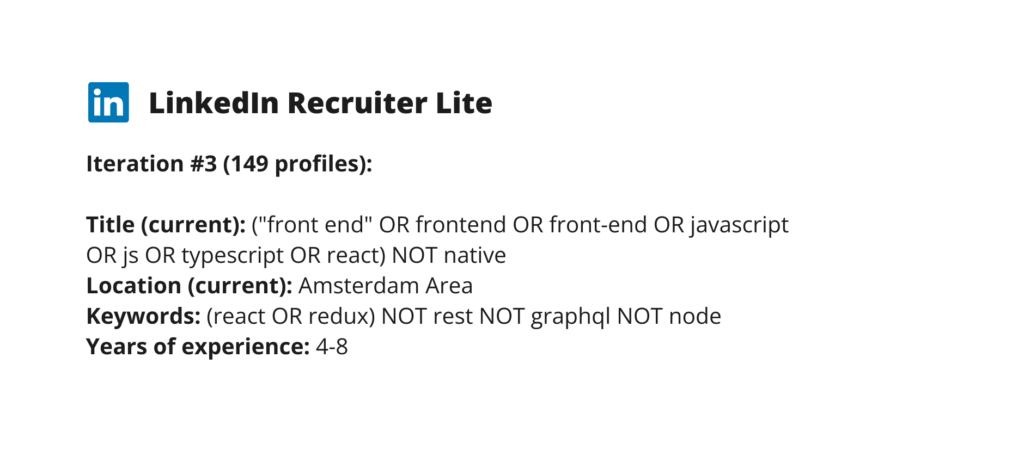
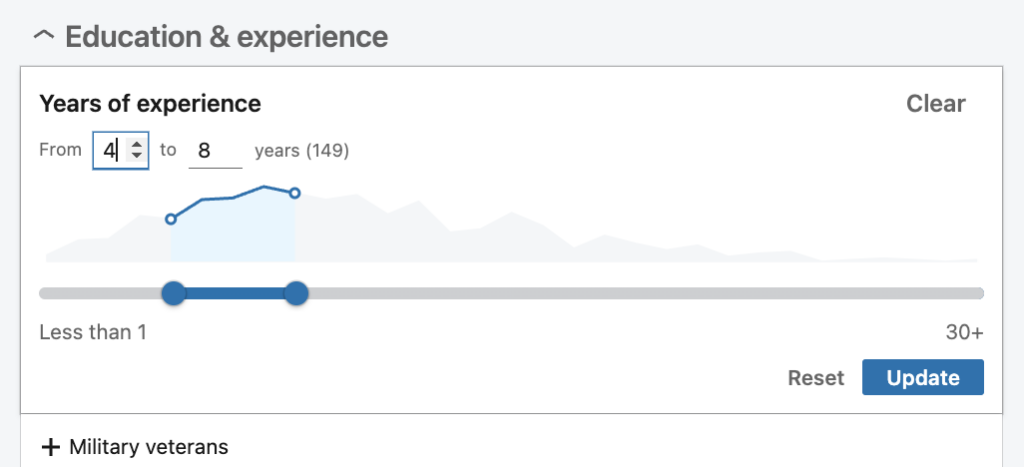
Setting Years of experience filter
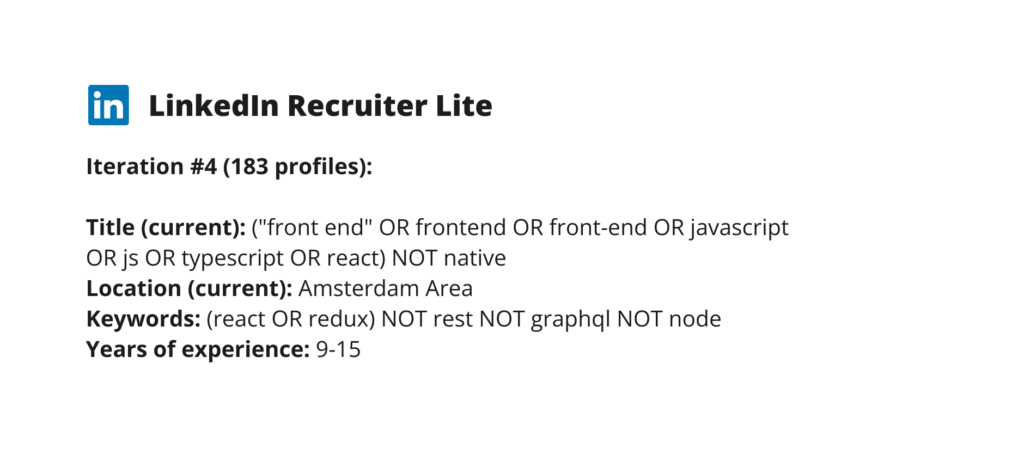
In this way, we will continue designing and introducing new differentiators or reusing the old ones. You do not want to overdo it though! Realistically with these 4 iterations that cover around 630 profiles of most fitting prospects I’m interested in, I’d already jump in!
4. Move to Sourcing Implementation
And that’s it, your sourcing planning is ready and you can start going through the profiles and identifying prospects. Go through the designed iterations and source using each search.
There are of course more ways to address the same requirements, e.g. focusing on keywords instead of titles. I do not like getting overwhelmed when sourcing, so I also create something that I call an “Idea dump”, a simple list of ideas, where I collect all the insights and new ways of searching I want to try before I know that, within the current search strategy, I have exhausted the talent pool. Idea dump is very useful because you learn about your talent pool while you source and it is the perfect time to identify another keyword (or the way those professionals refer to themselves) and use that to have a more inclusive sourcing technique.
Iterative sourcing can be translated to X-ray, or internal search of other platforms you are using. My goal here was to show the overall principle of how this works using a simple example. If it is not fully clear, do not panic! This concept might be a bit harder to grasp, give yourself some time and of course, you can always reach out to me to discuss. 🫶🏽 After a while, this will become a “muscle memory”!
Donor Sourcing
Sometimes when searching for passive talent, especially in the executive search, the number one most important characteristic you are looking for are the companies they work for or used to work for. Something like “ background in Big 5” for consultants, or they need to have worked in a “Series A startup” as a core requirement is our cue to go for donor sourcing, i.e. source the company first and talent afterwards.
Executive search sourcing has lots of specifics, maybe good material for another post, but what we need to know now: the number of people we need to source is considerably less (e.g. 50 people as the total number of sourced is typically more than enough to have a rich pipeline/hire) but the profile quality is even more important for each prospect you have.
1. Research and source the companies.
This is where Bard or ChatGPT (preferably with network access) is already very valuable. A simple LinkedIn company search, Crunchbase or similar platforms are another way to get your list. I will target something around 10 or so companies.

Prompt for Bard (I’m experimenting with it now): You are an expert in the Netherlands market. List the top 20 e-commerce B2C companies. Names + one sentence sum up of the company.
The list you get is typically plausible regardless of the tool you use. What I do next is find each company’s LinkedIn, webpage and further research on it. If you run out of meaningful options Bard can provide (not easy 🙂), you can go the “old way” and look for human-generated articles on Google, another great source is Crunchbase lists.
2. Set basic talent search criteria.
“They need to have experience with e-commerce B2C business” Part of our requirements is already covered by the company list. We need to make sure the other part “We are looking for a VP of Product within the Netherlands” is also covered.
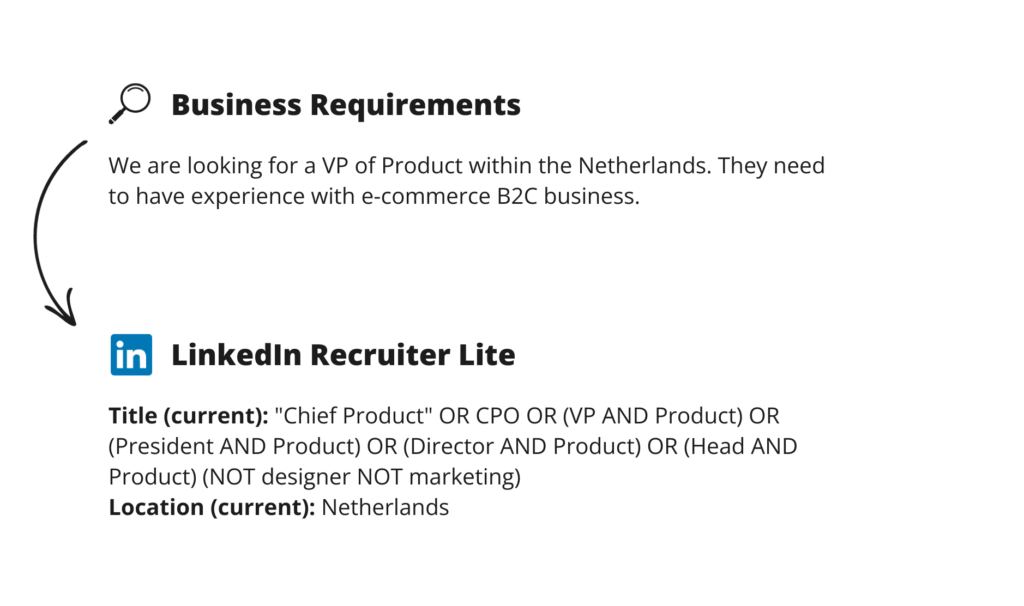
3. Bring the company and profile together.
We add to basic talent search criteria the companies. I will do this one by one so that I can give it my all attention and if I feel something is off I can dive deeper and troubleshoot.
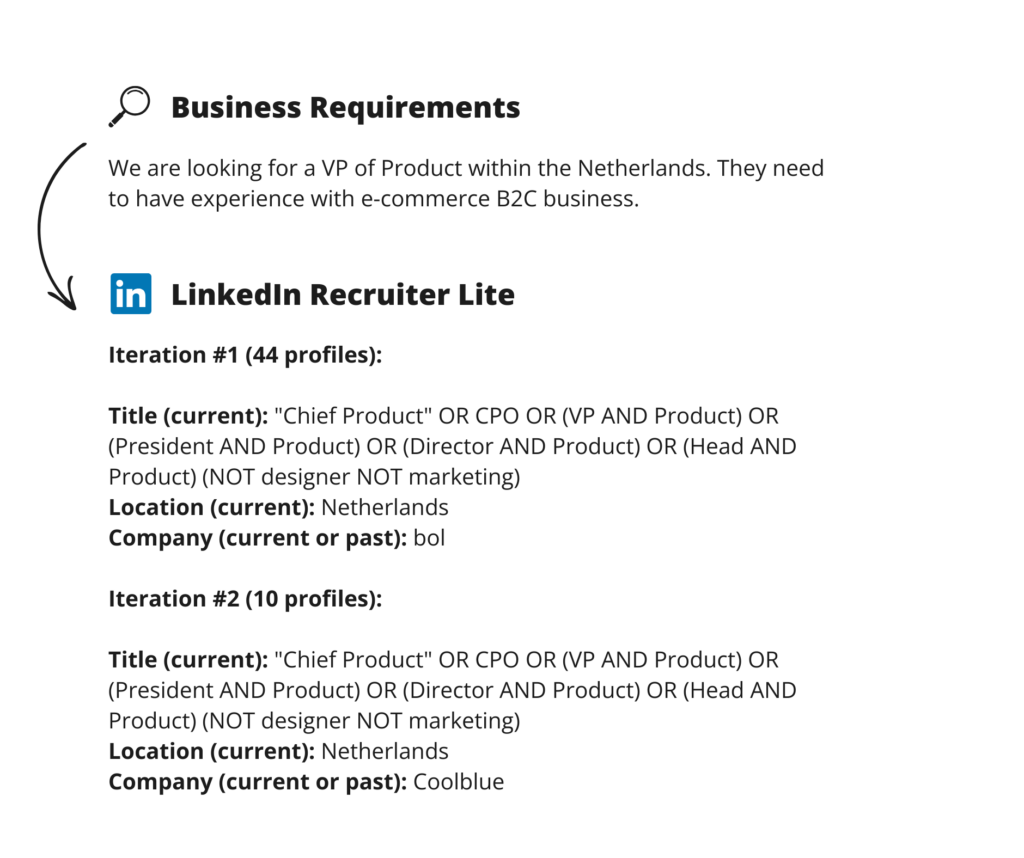
4. Repeat
So on and so forth for the all companies you have until happy with the amount of sourced profiles. For some companies, search doesn’t yield a lot of results. This can happen but it is highly unlikely, so I will experiment with keywords, maybe they use other leadership titles or different languages or they internally call it “platform” instead of “product”. The last resort is to also look for company org charts on their webpage for leadership or governance or on webpages like theorg.com.
In the case of donor sourcing, it is a bit harder to reduce the number of overlaps because someone who worked for company 1 also can work(ed) for company 2 and each profile is too valuable to miss. My way is to go through all the profiles or if it’s too overwhelming, exclude companies that I already looked at. Another way to avoid this is to focus on the current company only or just simply use LinkedIn projects or the power of your ATS to avoid duplicates.
Track, Tally, Repeat: The Sourcing Tracking Mantra
Iterative sourcing, donor sourcing or anything else, it is crucial to keep track of your sourcing effort. The table below is a simple and schematic representation of what I use. You can use it as a guide or an example to get inspired.
| Iteration number | String description | # of profiles in iteration | # of sourced profiles, ready to reach out |
|---|---|---|---|
| Iteration 1 | Keyword#1 AND Keyword#2 AND Keyword#3 AND Keyword#4 | 156 | 65 |
| Iteration 1.1 | (Keyword#1 AND Keyword#2 AND Keyword#3 AND Keyword#4) AND Keyword#5 | 76 | 35 |
| Iteration 1.2 | (Keyword#1 AND Keyword#2 AND Keyword#3 AND Keyword#4) NOT Keyword#5 | 80 | 23 |
| Iteration 2 | |||
| Iteration 2.1 | |||
| Iteration 2.2 | |||
| Iteration 3 | |||
| Idea dump | |||
| Keyword#6 | replacement of Keyword#1? | ||
| Keyword#7 | abbreviated way of saying Keyword#3 |
Your tracking can live wherever you keep your sourcing details from Notes to Google Sheets. It doesn’t require anything fancy, I use Notion for this as it is where our overall recruitment “documentation” lives. Very comfortable, can recommend but do not let a tool choice be a blocker here, go for your favourite tool!
Final words: Travolta again? 🫨
I hope there are no copyright laws that will bite me in the arc for using Travolta’s name. 😁
Anyways, sometimes you hit the bottom of your available market: you run out of talent to consider, but for real this time. This is especially true for serial positions or very unique skill sets. In this case, you are ready now and have data on your side! You are going back to the Search Strategy stage and discussing it with your hiring manager. Typically you compromise on one of the requirements: anything from geography to language knowledge or specific professional skill.
That’s my technique to stay on top of my sourcing and not get lost. I want to be real here – not every search requires this approach. If you have a quick search or some really easy sourcing, you can skip this method because it’s not worth it. But the rest of the time it provides good insight and a data-driven base for conversation inside the talent acquisition team or with the hiring manager.

